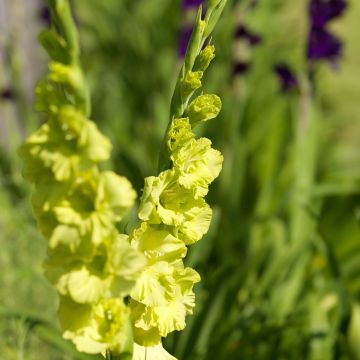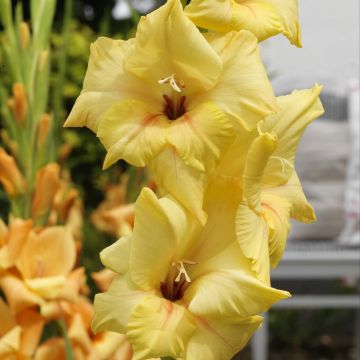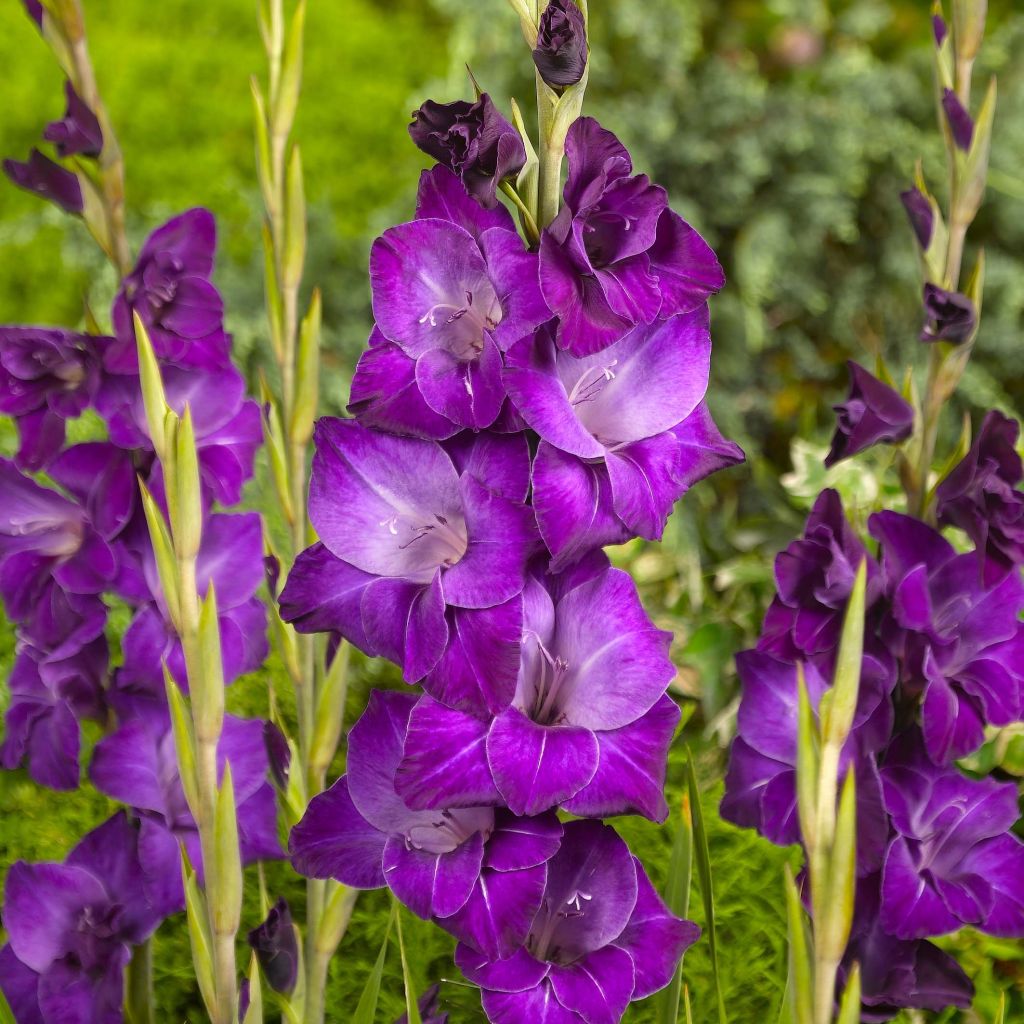

Gladiolus Violetta - Sword Lily
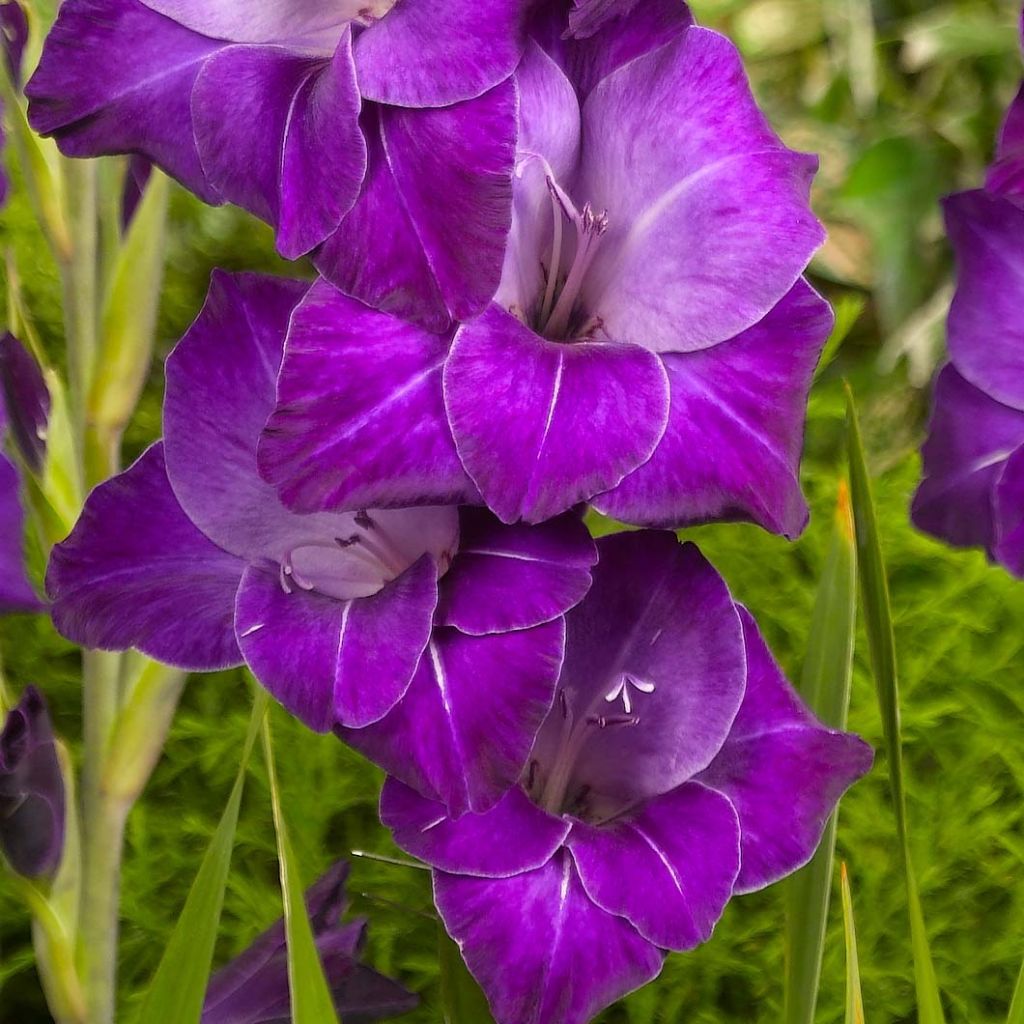

Gladiolus Violetta - Sword Lily
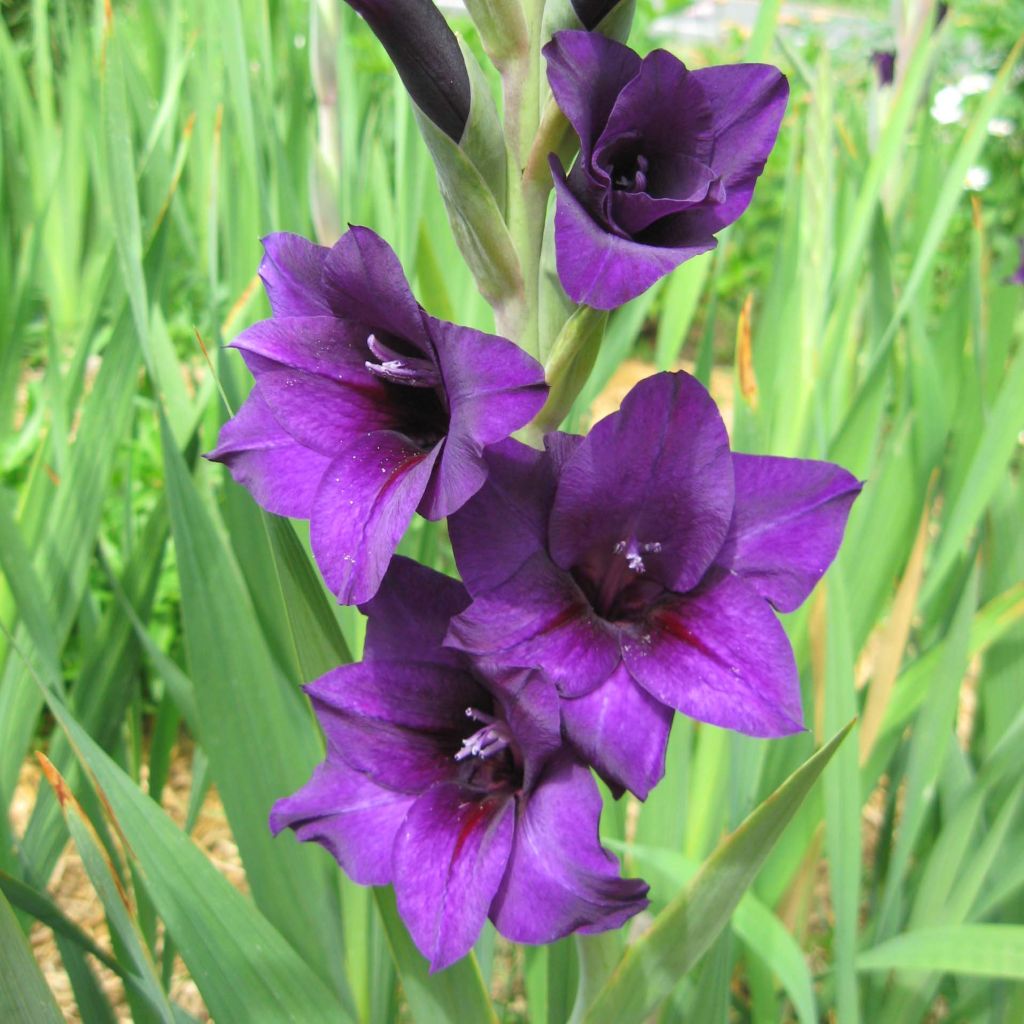

Gladiolus Violetta - Sword Lily
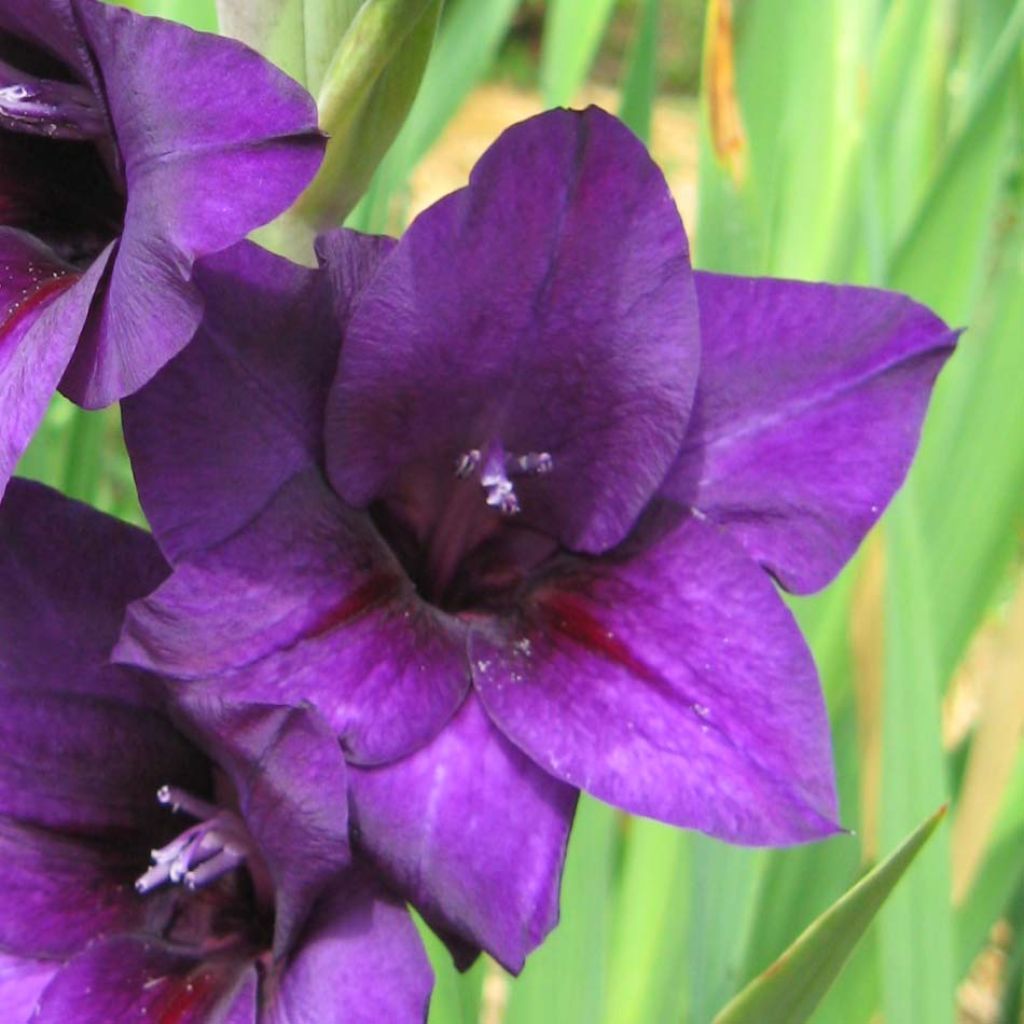

Gladiolus Violetta - Sword Lily
Gladiolus Violetta - Sword Lily
Gladiolus x grandiflorus (Butterfly) Violetta
Large-Flowered Gladiolus, Sword Lily
no flowers in 2020
Josseline, 13/02/2021
Why not try an alternative variety in stock?
View all →This plant carries a 6 months recovery warranty
More information
We guarantee the quality of our plants for a full growing cycle, and will replace at our expense any plant that fails to recover under normal climatic and planting conditions.
From €5.90 for pickup delivery and €6.90 for home delivery
Express home delivery from €8.90.

Does this plant fit my garden?
Set up your Plantfit profile →
Description
The hybrid Gladiolus 'Violetta' is distinguished by its beautiful flowers of a fine royal purple with white-silver edges, with a white throat. Light and airy like certain irises, they are tightly packed together and arranged symmetrically on sturdy and harmonious flower stalks. They bloom in summer, emerging from a fan-shaped clump of long leaves. We deliver them in large sizes of 14+ for the best flowering.
Cultivated gladioli, belonging to the family Iridaceae, are hybrid plants. They are divided into 3 main groups: Grandiflorus (large-flowered), Primulinus (early-flowering), and Nanus (butterfly). 'Violetta', registered in 1992 in the Netherlands, belongs to the first group, although it also carries the genes of the Gladiolus papilio. It is a perennial herbaceous plant with broad sword-shaped leaves arranged in a fan shape, forming a clump that reaches about 1m (3ft) in height when in bloom, under good conditions. The leaves are topped by a dense spike inflorescence, with numerous 6-petaled flowers that are open and about 6-8 cm (2-3in) wide. Each flower consists of 3 smaller petals arranged in quincunx with 3 larger sepals. The majority of the flowers are a beautiful pure and intense violet, crossed by a thin white line. The petals are finely marginate with white-silver edges. The flowers open from the bottom to the top of the spike, for about 2 weeks between July and September, depending on the planting date. The storage organ is a corm, which is a swollen stem with scales. To enjoy flowers throughout the summer, plant your corms at 15-day intervals, from March to May.
Gladioli and their long colourful flower stalks are symbolic of the 70s and slightly formal floral arrangements. While they are irreplaceable in bouquets, in gardens, their silhouette needs the presence of lush foliage or delicate flowers that will enhance their loaded but wildly romantic flowering. Plant 'Violetta' corms among clumps of sage, tobacco, bee balm, and forget-me-nots, for example. Or among small ornamental grasses like Stipa or blue fescue. They are regulars in cottage gardens, where they accompany vegetables even in the vegetable patch. For making bouquets, cut the flower stalks when the first floret starts to open. Plant them at intervals of two weeks from early spring until the end of June to bring flowers to the house and garden all summer long.
The gladiolus owes its name to the shape of its sword-like leaves, derived from the Latin gladius. Its wild forms were often depicted in jewelry or on carpets and fabrics made by the Semitic people before the Christian era.
Report an error about the product description
Gladiolus Violetta - Sword Lily in pictures
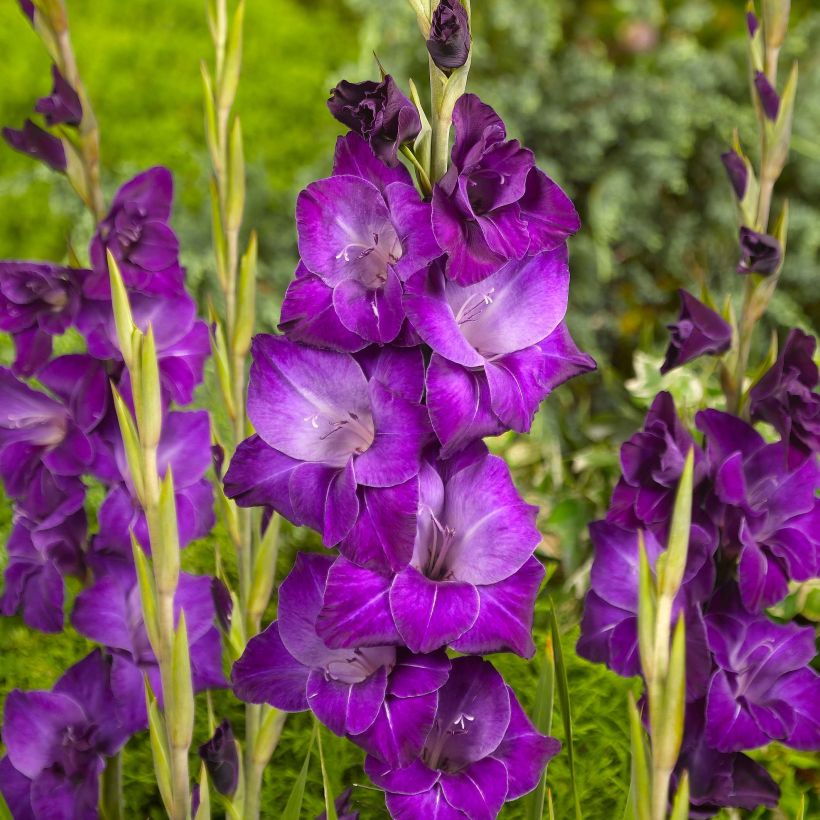



Plant habit
Flowering
Foliage
Botanical data
Gladiolus
x grandiflorus
(Butterfly) Violetta
Iridaceae
Large-Flowered Gladiolus, Sword Lily
Cultivar or hybrid
Other Gladioli
Planting and care
Gladioli hybrids like rich, fertile but well-drained soil, preferably sandy. Plant in full sun. Space the bulbs or corms 10 to 15cm (4 to 6in) apart and cover with 10cm (4in) of soil. Fertilise after cutting the flowers. Avoid using manure, as it promotes bulb rot. Gladioli are susceptible to frost, so they should be dug up when they have withered or immediately after the first frosts. Cut the leaves and let them dry in a well-ventilated place for three weeks. Separate the old bulbs. Store the new bulbs and bulblets throughout the winter in a cool place, protected from frost. The bulblets will bloom in two years.
Planting period
Intended location
Care
-
, onOrder confirmed
Reply from on Promesse de fleurs
Haven't found what you were looking for?
Hardiness is the lowest winter temperature a plant can endure without suffering serious damage or even dying. However, hardiness is affected by location (a sheltered area, such as a patio), protection (winter cover) and soil type (hardiness is improved by well-drained soil).

Photo Sharing Terms & Conditions
In order to encourage gardeners to interact and share their experiences, Promesse de fleurs offers various media enabling content to be uploaded onto its Site - in particular via the ‘Photo sharing’ module.
The User agrees to refrain from:
- Posting any content that is illegal, prejudicial, insulting, racist, inciteful to hatred, revisionist, contrary to public decency, that infringes on privacy or on the privacy rights of third parties, in particular the publicity rights of persons and goods, intellectual property rights, or the right to privacy.
- Submitting content on behalf of a third party;
- Impersonate the identity of a third party and/or publish any personal information about a third party;
In general, the User undertakes to refrain from any unethical behaviour.
All Content (in particular text, comments, files, images, photos, videos, creative works, etc.), which may be subject to property or intellectual property rights, image or other private rights, shall remain the property of the User, subject to the limited rights granted by the terms of the licence granted by Promesse de fleurs as stated below. Users are at liberty to publish or not to publish such Content on the Site, notably via the ‘Photo Sharing’ facility, and accept that this Content shall be made public and freely accessible, notably on the Internet.
Users further acknowledge, undertake to have ,and guarantee that they hold all necessary rights and permissions to publish such material on the Site, in particular with regard to the legislation in force pertaining to any privacy, property, intellectual property, image, or contractual rights, or rights of any other nature. By publishing such Content on the Site, Users acknowledge accepting full liability as publishers of the Content within the meaning of the law, and grant Promesse de fleurs, free of charge, an inclusive, worldwide licence for the said Content for the entire duration of its publication, including all reproduction, representation, up/downloading, displaying, performing, transmission, and storage rights.
Users also grant permission for their name to be linked to the Content and accept that this link may not always be made available.
By engaging in posting material, Users consent to their Content becoming automatically accessible on the Internet, in particular on other sites and/or blogs and/or web pages of the Promesse de fleurs site, including in particular social pages and the Promesse de fleurs catalogue.
Users may secure the removal of entrusted content free of charge by issuing a simple request via our contact form.
The flowering period indicated on our website applies to countries and regions located in USDA zone 8 (France, the United Kingdom, Ireland, the Netherlands, etc.)
It will vary according to where you live:
- In zones 9 to 10 (Italy, Spain, Greece, etc.), flowering will occur about 2 to 4 weeks earlier.
- In zones 6 to 7 (Germany, Poland, Slovenia, and lower mountainous regions), flowering will be delayed by 2 to 3 weeks.
- In zone 5 (Central Europe, Scandinavia), blooming will be delayed by 3 to 5 weeks.
In temperate climates, pruning of spring-flowering shrubs (forsythia, spireas, etc.) should be done just after flowering.
Pruning of summer-flowering shrubs (Indian Lilac, Perovskia, etc.) can be done in winter or spring.
In cold regions as well as with frost-sensitive plants, avoid pruning too early when severe frosts may still occur.
The planting period indicated on our website applies to countries and regions located in USDA zone 8 (France, United Kingdom, Ireland, Netherlands).
It will vary according to where you live:
- In Mediterranean zones (Marseille, Madrid, Milan, etc.), autumn and winter are the best planting periods.
- In continental zones (Strasbourg, Munich, Vienna, etc.), delay planting by 2 to 3 weeks in spring and bring it forward by 2 to 4 weeks in autumn.
- In mountainous regions (the Alps, Pyrenees, Carpathians, etc.), it is best to plant in late spring (May-June) or late summer (August-September).
The harvesting period indicated on our website applies to countries and regions in USDA zone 8 (France, England, Ireland, the Netherlands).
In colder areas (Scandinavia, Poland, Austria...) fruit and vegetable harvests are likely to be delayed by 3-4 weeks.
In warmer areas (Italy, Spain, Greece, etc.), harvesting will probably take place earlier, depending on weather conditions.
The sowing periods indicated on our website apply to countries and regions within USDA Zone 8 (France, UK, Ireland, Netherlands).
In colder areas (Scandinavia, Poland, Austria...), delay any outdoor sowing by 3-4 weeks, or sow under glass.
In warmer climes (Italy, Spain, Greece, etc.), bring outdoor sowing forward by a few weeks.









































